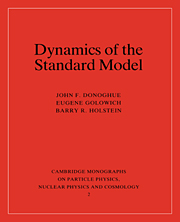Book contents
- Frontmatter
- Contents
- Preface
- I Inputs to the Standard Model
- II Interactions of the Standard Model
- III Symmetries and anomalies
- IV Introduction to effective lagrangians
- V Leptons
- VI Very low energy QCD – pions and photons
- VII Introducing kaons and etas
- VIII Kaons and the ΔS = 1 interaction
- IX Kaon mixing and CP violation
- X The Nc-1 expansion
- XI Phenomenological models
- XII Baryon properties
- XIII Hadron spectroscopy
- XIV Weak interactions of heavy quarks
- XV The Higgs boson
- XVI The electroweak gauge bosons
- A Appendix – Functional integration
- B Appendix – Some field theoretic methods
- C Appendix – Useful formulae
- References
- Index
I - Inputs to the Standard Model
Published online by Cambridge University Press: 06 January 2010
- Frontmatter
- Contents
- Preface
- I Inputs to the Standard Model
- II Interactions of the Standard Model
- III Symmetries and anomalies
- IV Introduction to effective lagrangians
- V Leptons
- VI Very low energy QCD – pions and photons
- VII Introducing kaons and etas
- VIII Kaons and the ΔS = 1 interaction
- IX Kaon mixing and CP violation
- X The Nc-1 expansion
- XI Phenomenological models
- XII Baryon properties
- XIII Hadron spectroscopy
- XIV Weak interactions of heavy quarks
- XV The Higgs boson
- XVI The electroweak gauge bosons
- A Appendix – Functional integration
- B Appendix – Some field theoretic methods
- C Appendix – Useful formulae
- References
- Index
Summary
This book is about the Standard Model of elementary particle physics. If we set the beginning of the modern era of particle physics in 1947, the year the pion was discovered, then the ensuing years of research have revealed the existence of a consistent, self-contained layer of reality. The energy range which defines this layer of reality extends up to several hundred GeV, or in terms of length, down to distances of order 10−16 cm. The Standard Model is a field-theoretic description of strong and electroweak interactions at these energies. It requires as input nineteen independent parameters. These parameters are not explained by the Standard Model; their presence implies the need for an understanding of Nature at an even deeper level. Nonetheless, processes described by the Standard Model possess a remarkable insulation from signals of such new physics. Although the strong interactions remain a calculational challenge, the Standard Model would appear to have sufficient content to describe all existing data. Thus far, it is a theoretical structure which has worked splendidly.
Quarks and leptons
In the Standard Model, the fundamental fermionic constitutents of matter are the quarks and the leptons. Quarks, but not leptons, engage in the strong interactions as a consequence of their color-charge. Each quark and lepton has spin one-half. Collectively, they display conventional Fermi-Dirac statistics. No attempt is made in the Standard Model either to explain the variety and number of quarks and leptons or to compute any of their properties.
Information
- Type
- Chapter
- Information
- Dynamics of the Standard Model , pp. 1 - 23Publisher: Cambridge University PressPrint publication year: 1992
Accessibility standard: Unknown
Why this information is here
This section outlines the accessibility features of this content - including support for screen readers, full keyboard navigation and high-contrast display options. This may not be relevant for you.Accessibility Information
- 4
- Cited by
